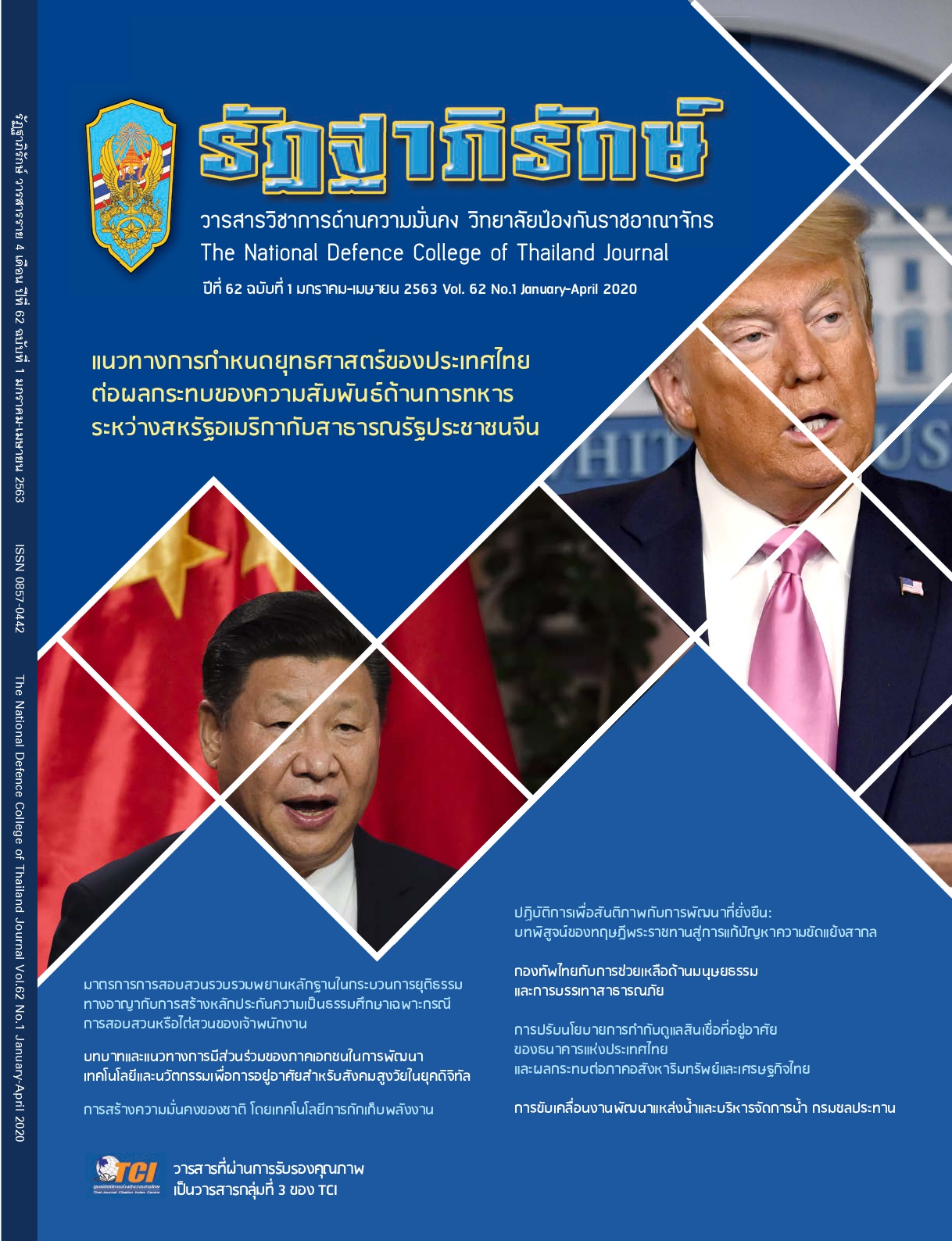บทบาทและแนวทางการมีส่วนร่วมของภาคเอกชนในการพัฒนาเทคโนโลยีและนวัตกรรมเพื่อการอยู่อาศัยสำหรับ สังคมสูงวัยในยุคดิจิทัล
คำสำคัญ:
การมีส่วนร่วม, การมีส่วนร่วมของภาคเอกชน, เทคโนโลยีและนวัตกรรมเพื่อการอยู่อาศัยสังคมสูงวัยยุคดิจิทัลบทคัดย่อ
บทคัดย่อ
เนื่องจากประเทศไทยกำลังจะเข้าสู่ “สังคมสูงวัยอย่างสมบูรณ์” (Completed Aged Society)
ในปี พ.ศ. 2564 กล่าวคือ มีจำนวนประชากรอายุ 60 ปีขึ้นไปถึงร้อยละ 20 ของจำนวนประชากร
ทั้งประเทศ ซึ่งที่อยู่อาศัยสำหรับผู้สูงวัยจะมีความต้องการเพิ่มมากขึ้น รวมถึงความก้าวหน้าด้านเทคโนโลยีและนวัตกรรมจะเข้ามามีส่วนสำคัญในการดำเนินชีวิตของผู้สูงวัยในอนาคต ด้วยเหตุดังกล่าวจึงได้ดำเนินการศึกษาบทบาทและการมีส่วนร่วมของภาคเอกชนในการพัฒนาเทคโนโลยีเพื่อการอยู่อาศัยสำหรับสังคมสูงวัยในยุคดิจิทัล โดยงานวิจัยดังกล่าวมีวัตถุประสงค์ คือ 1. ศึกษารูปแบบเทคโนโลยีและนวัตกรรมดิจิทัลเพื่อการอยู่อาศัย ทั้งนี้ เพื่อให้สอดคล้องกับวิถีการดำเนินชีวิต (Lifestyle) ของผู้ที่จะเข้าสู่สังคมสูงวัย 2. ศึกษาความต้องการในการเตรียมความพร้อมของผู้ที่จะเข้าสู่สังคมสูงวัยอย่างมีคุณภาพ (Active Aging) 3. ศึกษาบทบาทและแนวทางการมีส่วนร่วมของภาคเอกชนในการพัฒนาเทคโนโลยีและนวัตกรรมดิจิทัลขั้นพื้นฐานเพื่อที่จะช่วยอำนวยความสะดวกในการดำเนินชีวิตสำหรับสังคมสูงวัย โดยใช้ระเบียบวิธีวิจัยเชิงคุณภาพ (Qualitative Research) ด้วยการสัมภาษณ์กลุ่มตัวอย่างจำนวน 25 ราย ได้แก่ ผู้ประกอบการด้านเทคโนโลยี จำนวน5 ราย ผู้ประกอบการด้านที่อยู่อาศัยจำนวน 5 ราย กลุ่มบุคคลทั่วไป Baby Boomer, Generation X และ Y กลุ่มละ 5 ราย จากนั้นทำการวิเคราะห์ข้อมูลด้วยวิธีการวิเคราะห์เนื้อหา (Content Analysis) ซึ่งจากการวิจัยพบว่า 1. รูปแบบเทคโนโลยีและนวัตกรรมดิจิทัลเพื่อการอยู่อาศัยที่ผู้ให้ข้อมูลทุกกลุ่มต้องการเหมือนกันในอนาคต คือ เทคโนโลยีเพื่อความปลอดภัย เพื่อการดูแลสุขภาพทั้งกายและใจ และเพื่อความสะดวกสบาย รวมถึงการออกแบบที่อยู่อาศัยโดยยึดหลักอารยสถาปัตย์ 2. จากกรณีศึกษาที่อยู่อาศัยต้นแบบในปัจจุบันซึ่งได้มีการส่งเสริมคุณภาพชีวิตของผู้สูงอายุแต่เทคโนโลยีในที่อยู่อาศัยยังมีไม่มากนัก เนื่องจากอุปกรณ์เทคโนโลยียังมีราคาสูงและฐานข้อมูลความต้องการของผู้สูงอายุยังมีจำกัด 3. ภาคเอกชนสามารถเข้ามามีส่วนในการเตรียมความพร้อมการเข้าสู่สังคมสูงวัยได้โดยการร่วมมือกับภาครัฐ เช่น การร่วมลงทุนโครงการที่อยู่อาศัยสำหรับผู้สูงวัย การเข้ามารับสัมปทานของรัฐเพื่อพัฒนาเครือข่ายและความต้องการด้านเทคโนโลยีให้เข้าถึงคนทุกกลุ่มหรือการเข้ามาแข่งขันราคาเพื่อพัฒนาและขายอุปกรณ์ในราคาต่ำ นอกจากนี้ การวิจัยดังกล่าวมีข้อเสนอแนะ ซึ่งได้แก่ 1. ผู้ประกอบการด้านที่อยู่อาศัยและผู้ประกอบการด้านเทคโนโลยีและนวัตกรรมควรมีการดำเนินงานแบบบูรณการร่วมกันเพื่อออกแบบที่อยู่อาศัยที่สามารถรองรับเทคโนโลยีและนวัตกรรมดิจิทัลให้ทันต่อการเปลี่ยนแปลง 2.ควรมีการสนับสนุนและส่งเสริมการใช้งานเทคโนโลยีดิจิทัลในทุกๆ มิติของการดำเนินชีวิตของทุกช่วงวัย 3.ควรมีมาตรการด้านการลดภาษีหรือการกำหนดเงินกู้ดอกเบี้ยต่ำแก่ผู้ประกอบการและประชาชนที่ดำเนินกิจกรรมที่เกี่ยวข้องกับการส่งเสริมเทคโนโลยีเพื่อผู้สูงอายุ 4.เอกชนควรมีการร่วมมือกับสถาบันการศึกษาเพื่อศึกษาวิจัย คิดค้นเทคโนโลยีและนวัตกรรมต้นแบบเพื่อผู้สูงอายุที่จะสามารถนำไปต่อยอดในระบบอุตสาหกรรมของภาคเอกชนได้
คำสำคัญ การมีส่วนร่วม การมีส่วนร่วมของภาคเอกชน เทคโนโลยีและนวัตกรรมเพื่อการอยู่อาศัยสังคมสูงวัยยุคดิจิทัล
Abstract
In 2020, Thailand will inevitably enter “Completed Ages Society”, 20 percent of the total population will age more than 60 years old. Residences for elderly will be in high demand, and at the same time the advancement of technology and innovation will play a pivotal role in elderly’s living in the future. Thus, to investigate the role of private sector in developing technology and innovation for elderly’s living in digital era, the objectives of this research are : 1. to study types of technology for living that fit lifestyle of individuals entering aging society; 2. to examine steps in preparation of individuals under the concept “Active Aging”; and 3. to explore roles and participatory levels of private sector in developing fundamental digital technology to accommodate elderly’s living in aging society. This research was conducted by the qualitative basis, given a sample population of 25 consisting of 5 leading technology developers, 5 reputable real estate developers, 5 persons of Baby boomers, 5 persons of Generation X and 5 persons of Generation Y. From the content analysis, the results revealed that: 1. future digital technology for living in the aging society will be focused on safety both mind and body as well as provided more convenience to the elderly, given Universal Design as a standard; 2. the case study showed that the design of exemplary projects increase elderly’s quality of life; however there is no significant living technology presence due to high price of equipment and installation; and 3. there are several approaches that private sector can join force with public sector in preparation in entering aging society, for instance, public-private partnership in residential projects, developing infrastructure via government concession, and competitive bidding for price contestability. Additionally, the research suggested that: 1. for development side, both technology and real estate developers must work collaboratively and holistically in designing sustainable residential projects that yield the rapid change in future technology; 2. for citizen side, all age groups must become familiar with technology for living in the future; 3. for government side, there should be tax incentives to support developers in developing technology for elderly and financial stimulus to encourage the promotion of technology for elderly; and 4. for education side, private sector and institutions must join hand in research to develop new technology and innovation for elderly that can be scaled to the industrial mass production.
Keywords : Participation, Participatory Approaches of Private Sector, Technology and Innovation for Elderly’s Living, Digital Aging Society
ดาวน์โหลด
เผยแพร่แล้ว
ฉบับ
ประเภทบทความ
สัญญาอนุญาต
บทความ ข้อเขียน หรือความคิดเห็นในนิตยสารนี้เป็นของผู้เขียน ไม่ผูกพันกับวิทยาลัย ป้องกันราชอาณาจักรและทางราชการแต่อย่างใด



